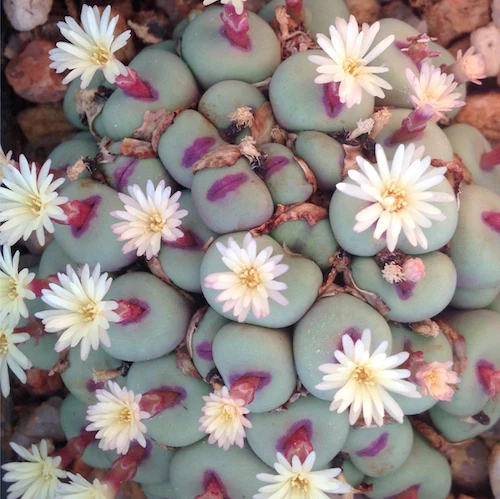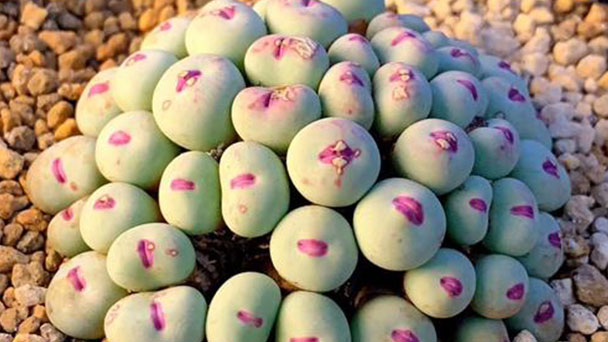Conophytum pageae, commonly known as Lips Plant, Cone Plant, Button Plant, or Dumplings, is a charming succulent celebrated for its distinctive shape and growth pattern. It is favored by many gardeners for its ease of cultivation.
Description:
C. pageae is a diminutive plant that thrives in rocky soil and outcroppings in southern Namibia and the Cape provinces of South Africa. Belonging to the Aizoaceae family, also known as the Ice Plant family, these succulents showcase remarkable diversity and beauty.
Named after Mary Maud Page, an English botanist who relocated to South Africa in 1911 to study the local plant life, Conophytum pageae forms clusters of individual plants or stemless "bodies" that are fig-shaped or inversely conical, reaching about 1" (2.5 cm) in height. Each body consists of two fused, dull, gray-green leaves with a puckered fissure at the top, rimmed in red, resembling two lips.
These petite plants go dormant during late spring and summer. As they enter dormancy, the outer leaves begin to shrivel while two new leaves form inside. The old outer leaves become thin and dry, serving to protect the young leaves as they grow.
In autumn, single, daisy-like flowers bloom nocturnally from the red-ringed fissure. Highly fragrant, these flowers come in yellow, rosy-pink, or white, eventually developing into small capsules containing numerous tiny seeds.
Conophytum pageae has an active growth period during the winter months before entering dormancy again in spring. These slow-growing succulents have a lifespan of over 50 years.
Uses of Conophytum pageae:
While plants in the Conophytum genus are believed to have sedative properties due to mesembrine alkaloids, their usage primarily revolves around horticulture. These appealing succulents are hardy and can thrive outdoors in warm regions, including rock gardens, alpine gardens, stone walls, and containers. Indoors, they make excellent houseplants when provided with proper care.
In recent years, illegal poaching of Conophytum species has threatened some populations in South Africa. However, conservation efforts have been implemented to protect these unique succulents, ensuring their continued existence.
Care for Conophytum pageae:
Light: Conophytums prefer bright light but should be shielded from direct, harsh afternoon sun to prevent tissue damage.
Temperature: These plants can tolerate a wide range of temperatures, from very hot to nearly freezing, thriving in USDA zones 10 and 11.
Humidity: Native to dry regions in Africa, Conophytums prefer low to medium humidity levels and benefit from good air circulation.
Soil: A porous, gritty potting mix with excellent drainage is ideal for these succulents, such as a cactus or succulent mix amended with perlite or sand.

Water: During the active growth period in fall and winter, water thoroughly when the soil dries out, allowing excess water to drain completely.
Propagation: Conophytums can be propagated from seed or division in late summer before the growth season begins. Sow seeds in a loose succulent mix and keep them moist until they sprout in two to four weeks. Divide clumps by cutting or separating several plants from a larger cluster and replant them, keeping them moist until they root.

Pests and Diseases: Conophytum pageae is relatively resistant to pests and diseases. Root mealybugs can be a concern, while root rot from overwatering is the primary disease to watch out for. Treat infestations with insecticide and ensure soil dries completely between waterings to prevent rot.




